[English] 日本語
 Yorodumi
Yorodumi- PDB-7piu: Cryo-EM structure of the agonist setmelanotide bound to the activ... -
+ Open data
Open data
- Basic information
Basic information
| Entry | Database: PDB / ID: 7piu | ||||||||||||
|---|---|---|---|---|---|---|---|---|---|---|---|---|---|
| Title | Cryo-EM structure of the agonist setmelanotide bound to the active melanocortin-4 receptor (MC4R) in complex with the heterotrimeric Gs protein at 2.6 A resolution. | ||||||||||||
 Components Components |
| ||||||||||||
 Keywords Keywords | SIGNALING PROTEIN / GPCR / MELANOCORTIN-4 RECEPTOR / MELANOCORTIN RECEPTORS / SETMELANOTIDE / NDP-ALPHA-MSH / ALPHA-MSH / ANTAGONISM / AGONISM / APPETITE REGULATION / ANTI-OBESITY TREATMENT | ||||||||||||
| Function / homology |  Function and homology information Function and homology informationregulation of eating behavior / melanocyte-stimulating hormone receptor activity / response to melanocyte-stimulating hormone / melanocortin receptor activity / regulation of grooming behavior / energy reserve metabolic process / G-protein activation / Activation of the phototransduction cascade / Glucagon-type ligand receptors / Thromboxane signalling through TP receptor ...regulation of eating behavior / melanocyte-stimulating hormone receptor activity / response to melanocyte-stimulating hormone / melanocortin receptor activity / regulation of grooming behavior / energy reserve metabolic process / G-protein activation / Activation of the phototransduction cascade / Glucagon-type ligand receptors / Thromboxane signalling through TP receptor / Sensory perception of sweet, bitter, and umami (glutamate) taste / G beta:gamma signalling through PI3Kgamma / G beta:gamma signalling through CDC42 / Cooperation of PDCL (PhLP1) and TRiC/CCT in G-protein beta folding / Activation of G protein gated Potassium channels / Inhibition of voltage gated Ca2+ channels via Gbeta/gamma subunits / Ca2+ pathway / G alpha (z) signalling events / Vasopressin regulates renal water homeostasis via Aquaporins / Glucagon-like Peptide-1 (GLP1) regulates insulin secretion / feeding behavior / regulation of metabolic process / neuropeptide binding / Adrenaline,noradrenaline inhibits insulin secretion / ADP signalling through P2Y purinoceptor 12 / G alpha (q) signalling events / Thrombin signalling through proteinase activated receptors (PARs) / insulin secretion / G alpha (i) signalling events / alkylglycerophosphoethanolamine phosphodiesterase activity / Activation of G protein gated Potassium channels / G-protein activation / G beta:gamma signalling through PI3Kgamma / Prostacyclin signalling through prostacyclin receptor / G beta:gamma signalling through PLC beta / ADP signalling through P2Y purinoceptor 1 / Thromboxane signalling through TP receptor / Presynaptic function of Kainate receptors / G beta:gamma signalling through CDC42 / Inhibition of voltage gated Ca2+ channels via Gbeta/gamma subunits / Glucagon-type ligand receptors / G alpha (12/13) signalling events / G beta:gamma signalling through BTK / ADP signalling through P2Y purinoceptor 12 / Adrenaline,noradrenaline inhibits insulin secretion / Cooperation of PDCL (PhLP1) and TRiC/CCT in G-protein beta folding / Thrombin signalling through proteinase activated receptors (PARs) / Ca2+ pathway / Extra-nuclear estrogen signaling / G alpha (z) signalling events / G alpha (s) signalling events / G alpha (q) signalling events / photoreceptor outer segment membrane / Glucagon-like Peptide-1 (GLP1) regulates insulin secretion / G alpha (i) signalling events / spectrin binding / negative regulation of feeding behavior / Vasopressin regulates renal water homeostasis via Aquaporins / diet induced thermogenesis / PKA activation in glucagon signalling / peptide hormone binding / hair follicle placode formation / developmental growth / photoreceptor outer segment / D1 dopamine receptor binding / intracellular transport / positive regulation of bone resorption / renal water homeostasis / Hedgehog 'off' state / Transcriptional and post-translational regulation of MITF-M expression and activity / adenylate cyclase-activating adrenergic receptor signaling pathway / activation of adenylate cyclase activity / cardiac muscle cell apoptotic process / cellular response to glucagon stimulus / adenylate cyclase activator activity / regulation of insulin secretion / photoreceptor inner segment / Peptide ligand-binding receptors / trans-Golgi network membrane / negative regulation of inflammatory response to antigenic stimulus / response to insulin / bone development / G-protein beta/gamma-subunit complex binding / adenylate cyclase-modulating G protein-coupled receptor signaling pathway / adenylate cyclase-activating G protein-coupled receptor signaling pathway / G protein activity / platelet aggregation / Prostacyclin signalling through prostacyclin receptor / Glucagon signaling in metabolic regulation / cognition / Glucagon-type ligand receptors / Vasopressin regulates renal water homeostasis via Aquaporins / G alpha (z) signalling events / Glucagon-like Peptide-1 (GLP1) regulates insulin secretion / cellular response to catecholamine stimulus / ADORA2B mediated anti-inflammatory cytokines production / sensory perception of taste / adenylate cyclase-activating dopamine receptor signaling pathway / GPER1 signaling / cellular response to prostaglandin E stimulus Similarity search - Function | ||||||||||||
| Biological species |  Homo sapiens (human) Homo sapiens (human)   synthetic construct (others) | ||||||||||||
| Method | ELECTRON MICROSCOPY / single particle reconstruction / cryo EM / Resolution: 2.58 Å | ||||||||||||
 Authors Authors | Heyder, N.A. / Schmidt, A. / Kleinau, G. / Hilal, T. / Scheerer, P. | ||||||||||||
| Funding support |  Germany, 3items Germany, 3items
| ||||||||||||
 Citation Citation |  Journal: Cell Res / Year: 2021 Journal: Cell Res / Year: 2021Title: Structures of active melanocortin-4 receptor-Gs-protein complexes with NDP-α-MSH and setmelanotide. Authors: Nicolas A Heyder / Gunnar Kleinau / David Speck / Andrea Schmidt / Sarah Paisdzior / Michal Szczepek / Brian Bauer / Anja Koch / Monique Gallandi / Dennis Kwiatkowski / Jörg Bürger / ...Authors: Nicolas A Heyder / Gunnar Kleinau / David Speck / Andrea Schmidt / Sarah Paisdzior / Michal Szczepek / Brian Bauer / Anja Koch / Monique Gallandi / Dennis Kwiatkowski / Jörg Bürger / Thorsten Mielke / Annette G Beck-Sickinger / Peter W Hildebrand / Christian M T Spahn / Daniel Hilger / Magdalena Schacherl / Heike Biebermann / Tarek Hilal / Peter Kühnen / Brian K Kobilka / Patrick Scheerer /   Abstract: The melanocortin-4 receptor (MC4R), a hypothalamic master regulator of energy homeostasis and appetite, is a class A G-protein-coupled receptor and a prime target for the pharmacological treatment of ...The melanocortin-4 receptor (MC4R), a hypothalamic master regulator of energy homeostasis and appetite, is a class A G-protein-coupled receptor and a prime target for the pharmacological treatment of obesity. Here, we present cryo-electron microscopy structures of MC4R-Gs-protein complexes with two drugs recently approved by the FDA, the peptide agonists NDP-α-MSH and setmelanotide, with 2.9 Å and 2.6 Å resolution. Together with signaling data from structure-derived MC4R mutants, the complex structures reveal the agonist-induced origin of transmembrane helix (TM) 6-regulated receptor activation. The ligand-binding modes of NDP-α-MSH, a high-affinity linear variant of the endogenous agonist α-MSH, and setmelanotide, a cyclic anti-obesity drug with biased signaling toward Gq/11, underline the key role of TM3 in ligand-specific interactions and of calcium ion as a ligand-adaptable cofactor. The agonist-specific TM3 interplay subsequently impacts receptor-Gs-protein interfaces at intracellular loop 2, which also regulates the G-protein coupling profile of this promiscuous receptor. Finally, our structures reveal mechanistic details of MC4R activation/inhibition, and provide important insights into the regulation of the receptor signaling profile which will facilitate the development of tailored anti-obesity drugs. | ||||||||||||
| History |
|
- Structure visualization
Structure visualization
| Movie |
 Movie viewer Movie viewer |
|---|---|
| Structure viewer | Molecule:  Molmil Molmil Jmol/JSmol Jmol/JSmol |
- Downloads & links
Downloads & links
- Download
Download
| PDBx/mmCIF format |  7piu.cif.gz 7piu.cif.gz | 208.7 KB | Display |  PDBx/mmCIF format PDBx/mmCIF format |
|---|---|---|---|---|
| PDB format |  pdb7piu.ent.gz pdb7piu.ent.gz | 164.9 KB | Display |  PDB format PDB format |
| PDBx/mmJSON format |  7piu.json.gz 7piu.json.gz | Tree view |  PDBx/mmJSON format PDBx/mmJSON format | |
| Others |  Other downloads Other downloads |
-Validation report
| Summary document |  7piu_validation.pdf.gz 7piu_validation.pdf.gz | 602.1 KB | Display |  wwPDB validaton report wwPDB validaton report |
|---|---|---|---|---|
| Full document |  7piu_full_validation.pdf.gz 7piu_full_validation.pdf.gz | 606 KB | Display | |
| Data in XML |  7piu_validation.xml.gz 7piu_validation.xml.gz | 32.8 KB | Display | |
| Data in CIF |  7piu_validation.cif.gz 7piu_validation.cif.gz | 47.8 KB | Display | |
| Arichive directory |  https://data.pdbj.org/pub/pdb/validation_reports/pi/7piu https://data.pdbj.org/pub/pdb/validation_reports/pi/7piu ftp://data.pdbj.org/pub/pdb/validation_reports/pi/7piu ftp://data.pdbj.org/pub/pdb/validation_reports/pi/7piu | HTTPS FTP |
-Related structure data
| Related structure data |  13453MC  7pivC M: map data used to model this data C: citing same article ( |
|---|---|
| Similar structure data |
- Links
Links
- Assembly
Assembly
| Deposited unit | 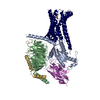
|
|---|---|
| 1 |
|
- Components
Components
-Protein , 2 types, 2 molecules RA
| #1: Protein | Mass: 38698.520 Da / Num. of mol.: 1 Source method: isolated from a genetically manipulated source Source: (gene. exp.)  Homo sapiens (human) / Gene: MC4R / Plasmid: pOET3 Homo sapiens (human) / Gene: MC4R / Plasmid: pOET3Production host:  Spodoptera aff. frugiperda 1 BOLD-2017 (butterflies/moths) Spodoptera aff. frugiperda 1 BOLD-2017 (butterflies/moths)References: UniProt: P32245 |
|---|---|
| #3: Protein | Mass: 44326.160 Da / Num. of mol.: 1 Source method: isolated from a genetically manipulated source Source: (gene. exp.)  Homo sapiens (human) / Gene: GNAS, GNAS1, GSP / Variant: 2 / Plasmid: pFastbac / Production host: Homo sapiens (human) / Gene: GNAS, GNAS1, GSP / Variant: 2 / Plasmid: pFastbac / Production host:  Trichoplusia ni (cabbage looper) / References: UniProt: P63092 Trichoplusia ni (cabbage looper) / References: UniProt: P63092 |
-Guanine nucleotide-binding protein ... , 2 types, 2 molecules BG
| #4: Protein | Mass: 37728.152 Da / Num. of mol.: 1 Source method: isolated from a genetically manipulated source Source: (gene. exp.)   Trichoplusia ni (cabbage looper) / References: UniProt: P54311 Trichoplusia ni (cabbage looper) / References: UniProt: P54311 |
|---|---|
| #5: Protein | Mass: 7861.143 Da / Num. of mol.: 1 Source method: isolated from a genetically manipulated source Source: (gene. exp.)   Trichoplusia ni (cabbage looper) / References: UniProt: P63212 Trichoplusia ni (cabbage looper) / References: UniProt: P63212 |
-Protein/peptide / Antibody , 2 types, 2 molecules PN
| #2: Protein/peptide | Mass: 1081.297 Da / Num. of mol.: 1 / Source method: obtained synthetically / Source: (synth.) synthetic construct (others) |
|---|---|
| #6: Antibody | Mass: 14714.320 Da / Num. of mol.: 1 Source method: isolated from a genetically manipulated source Source: (gene. exp.)   |
-Non-polymers , 2 types, 89 molecules 


| #7: Chemical | ChemComp-CA / |
|---|---|
| #8: Water | ChemComp-HOH / |
-Details
| Has ligand of interest | Y |
|---|
-Experimental details
-Experiment
| Experiment | Method: ELECTRON MICROSCOPY |
|---|---|
| EM experiment | Aggregation state: PARTICLE / 3D reconstruction method: single particle reconstruction |
- Sample preparation
Sample preparation
| Component | Name: Ternary complex of setmelanotide-activated melanocortin 4 receptor with heterotrimeric Gs, further stabilized by addition of nanobody 35 Type: COMPLEX / Entity ID: #1-#6 / Source: MULTIPLE SOURCES | ||||||||||||||||||||||||||||||||||||||||
|---|---|---|---|---|---|---|---|---|---|---|---|---|---|---|---|---|---|---|---|---|---|---|---|---|---|---|---|---|---|---|---|---|---|---|---|---|---|---|---|---|---|
| Molecular weight | Value: 144.1 kDa/nm / Experimental value: YES | ||||||||||||||||||||||||||||||||||||||||
| Source (natural) |
| ||||||||||||||||||||||||||||||||||||||||
| Buffer solution | pH: 7.5 | ||||||||||||||||||||||||||||||||||||||||
| Buffer component |
| ||||||||||||||||||||||||||||||||||||||||
| Specimen | Conc.: 5 mg/ml / Embedding applied: NO / Shadowing applied: NO / Staining applied: NO / Vitrification applied: YES | ||||||||||||||||||||||||||||||||||||||||
| Specimen support | Grid material: GOLD / Grid type: UltrAuFoil R1.2/1.3 | ||||||||||||||||||||||||||||||||||||||||
| Vitrification | Instrument: FEI VITROBOT MARK IV / Cryogen name: ETHANE / Humidity: 100 % / Chamber temperature: 283.15 K |
- Electron microscopy imaging
Electron microscopy imaging
| Experimental equipment |  Model: Titan Krios / Image courtesy: FEI Company |
|---|---|
| Microscopy | Model: FEI TITAN KRIOS |
| Electron gun | Electron source:  FIELD EMISSION GUN / Accelerating voltage: 300 kV / Illumination mode: FLOOD BEAM FIELD EMISSION GUN / Accelerating voltage: 300 kV / Illumination mode: FLOOD BEAM |
| Electron lens | Mode: BRIGHT FIELD / Nominal magnification: 96000 X / Nominal defocus max: 2000 nm / Nominal defocus min: 800 nm / Cs: 2.7 mm / C2 aperture diameter: 50 µm / Alignment procedure: ZEMLIN TABLEAU |
| Specimen holder | Cryogen: NITROGEN / Specimen holder model: FEI TITAN KRIOS AUTOGRID HOLDER |
| Image recording | Average exposure time: 40.78 sec. / Electron dose: 40 e/Å2 / Detector mode: COUNTING / Film or detector model: FEI FALCON III (4k x 4k) / Num. of grids imaged: 1 / Num. of real images: 7583 |
- Processing
Processing
| EM software |
| ||||||||||||||||||||||||||||||||||||||||||||||||||||||||||||
|---|---|---|---|---|---|---|---|---|---|---|---|---|---|---|---|---|---|---|---|---|---|---|---|---|---|---|---|---|---|---|---|---|---|---|---|---|---|---|---|---|---|---|---|---|---|---|---|---|---|---|---|---|---|---|---|---|---|---|---|---|---|
| CTF correction | Type: PHASE FLIPPING AND AMPLITUDE CORRECTION | ||||||||||||||||||||||||||||||||||||||||||||||||||||||||||||
| Particle selection | Num. of particles selected: 4330500 | ||||||||||||||||||||||||||||||||||||||||||||||||||||||||||||
| Symmetry | Point symmetry: C1 (asymmetric) | ||||||||||||||||||||||||||||||||||||||||||||||||||||||||||||
| 3D reconstruction | Resolution: 2.58 Å / Resolution method: FSC 0.143 CUT-OFF / Num. of particles: 370621 / Symmetry type: POINT | ||||||||||||||||||||||||||||||||||||||||||||||||||||||||||||
| Atomic model building | Protocol: RIGID BODY FIT / Space: REAL | ||||||||||||||||||||||||||||||||||||||||||||||||||||||||||||
| Atomic model building | PDB-ID: 7PIV |
 Movie
Movie Controller
Controller



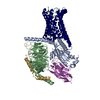
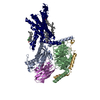

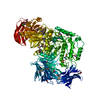
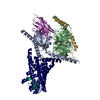
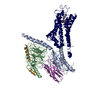

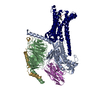

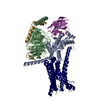
 PDBj
PDBj





















